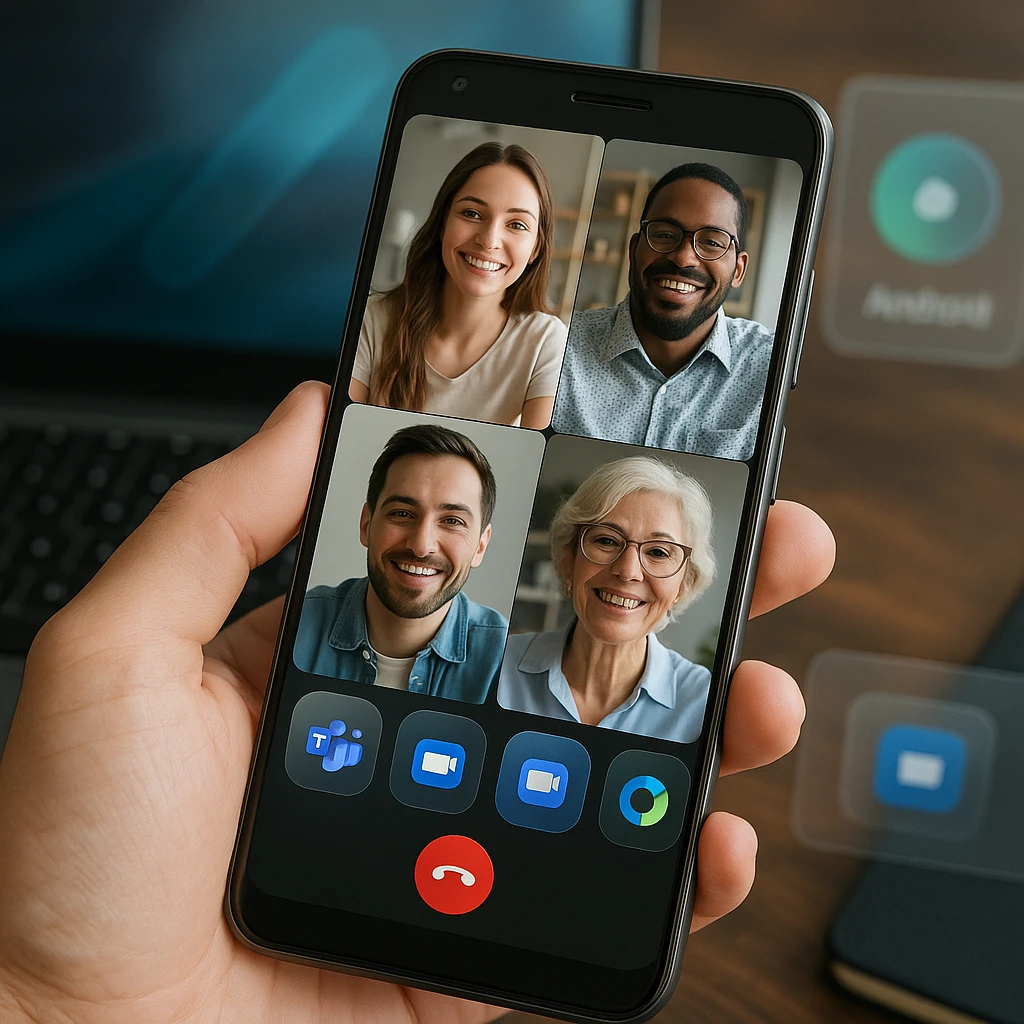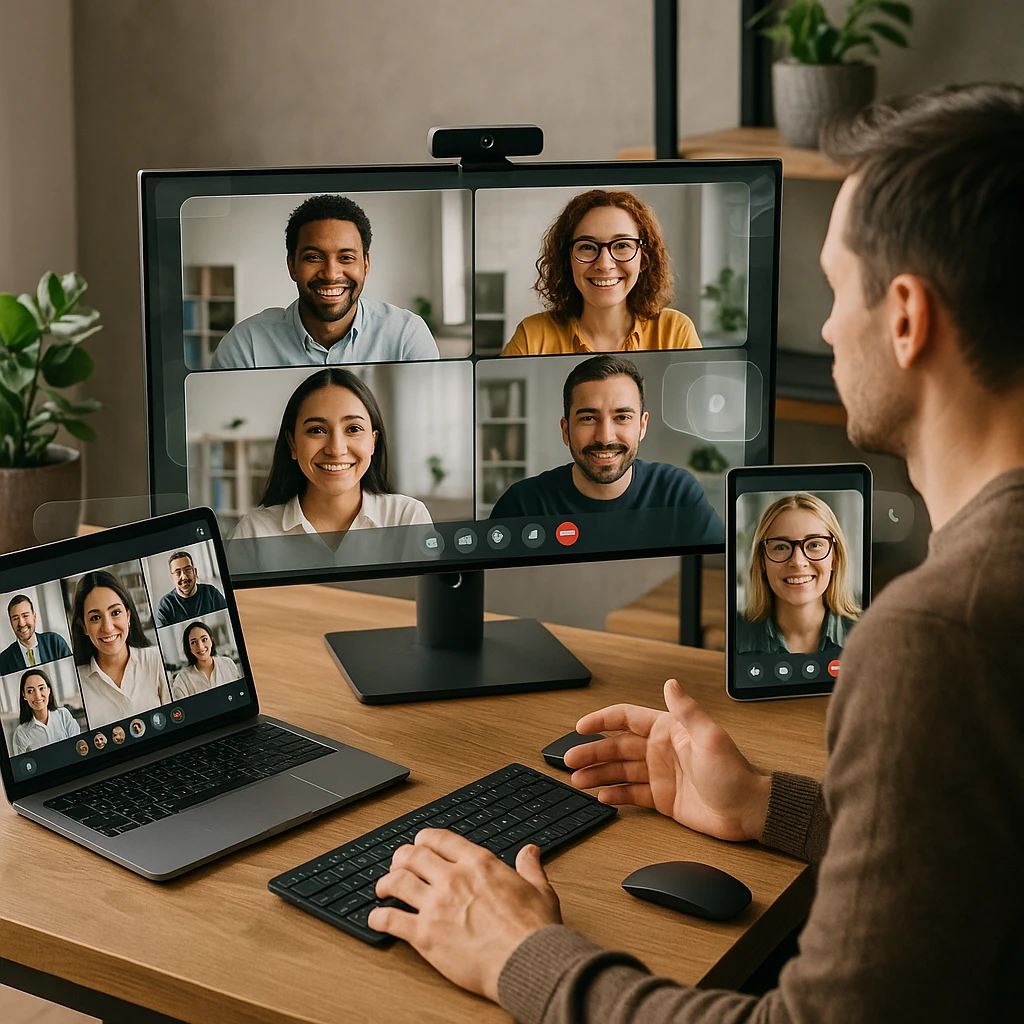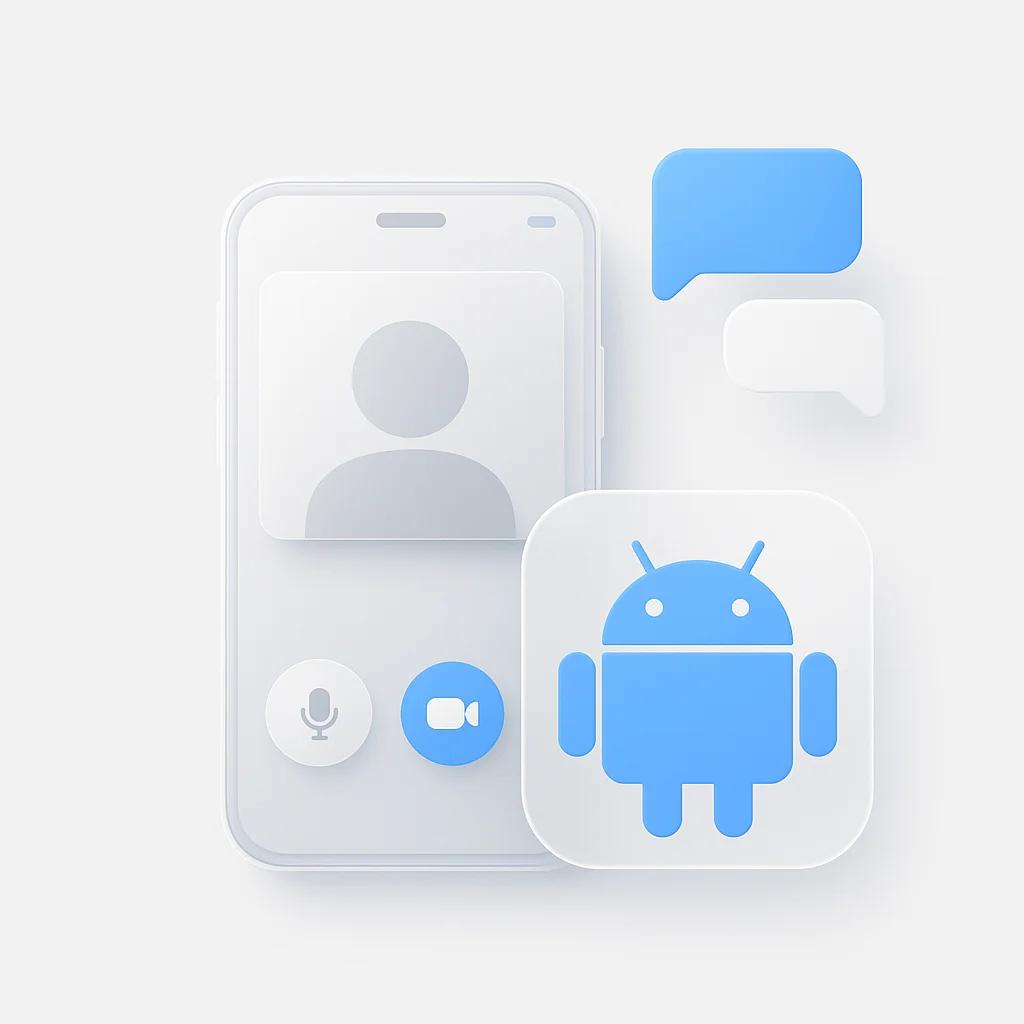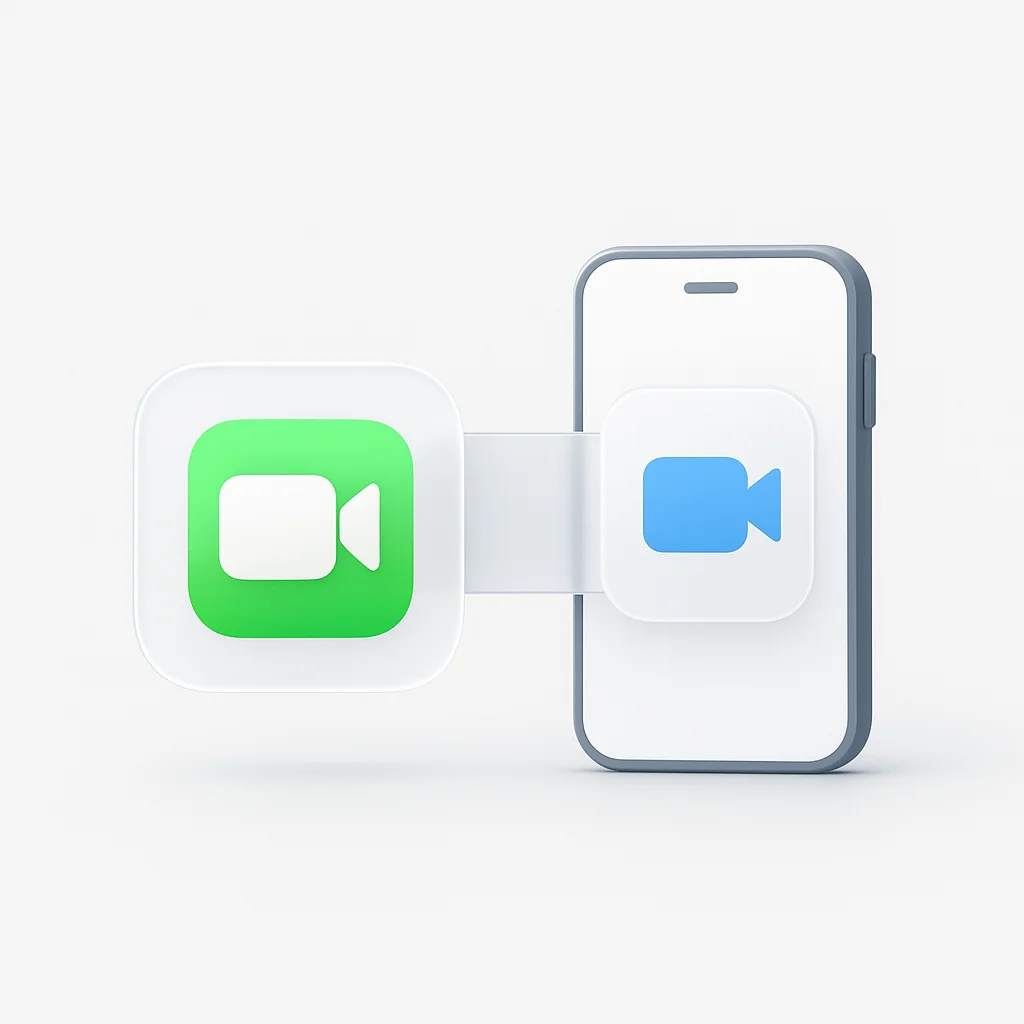The way we connect has fundamentally changed. Video chat has evolved from a novelty to an essential part of daily communication, especially on Android devices where over 70% of mobile users rely on Android for their communication needs.
Whether you’re catching up with family, collaborating with remote teams, or conducting business meetings, choosing the right Android video chat app can make all the difference. This guide covers the top 10 Android video chat apps for 2025, helping you find the perfect solution for your specific needs.

Comparison Table: Android Video Chat Apps at a Glance
| App | Best For | Max Participants | Key Features | Price | Security |
|---|---|---|---|---|---|
| Zoom | Professional | 100 (free) 1,000+ (paid) |
AI features, breakout rooms, recording | Free + Paid plans | E2EE |
| Google Meet | Google Users | 100 (free) 500+ (paid) |
Calendar integration, live captions | Free + Paid plans | Encrypted |
| Microsoft Teams | Business | 100 (free) 1,000+ (paid) |
365 integration, collaboration tools | Free + Paid plans | Enterprise |
| Personal | 8 participants | Simple interface, widespread use | Free | E2EE | |
| Signal | Privacy | 8 participants | Maximum privacy, open source | Free | E2EE |
| Skype | General | 50 participants | International calling, screen sharing | Free + Credits | Encrypted |
| Discord | Communities | 25 participants | Servers, channels, screen sharing | Free + Nitro | Encrypted |
| Jitsi Meet | Privacy | 75 participants | No account needed, open source | Free | E2EE |
| Viber | Regional | 20 participants | Regional popularity, secure messaging | Free | E2EE |
| Facebook Messenger | Social | 50 participants | Facebook integration, fun filters | Free | Encrypted |
What Makes a Great Android Video Chat App in 2025?
Before diving into the apps, let’s understand what separates excellent video chat solutions from mediocre ones. Think of it like choosing a car—you want reliability, safety, and features that make your journey smooth.
Security & Privacy: Your Digital Fortress
End-to-end encryption (E2EE) is no longer optional—it’s essential. With 79% of Americans concerned about data privacy, your video chat app must protect your conversations like a vault.
Real-world example: When Sarah, a healthcare consultant, discusses patient cases with colleagues, she needs absolute confidence that her conversations stay private. Apps like Signal and WhatsApp provide this peace of mind with military-grade encryption.
What to look for:
- End-to-end encryption for all communications
- No data collection or tracking
- User control over privacy settings
- Regular security updates
Performance & Quality: The Smooth Experience
HD video quality, stable connections, and efficient data usage are crucial for mobile users. The best apps optimize for Android’s diverse hardware ecosystem.
Real-world example: Mike, a sales representative, often conducts client calls while traveling. He needs an app that works reliably on 4G networks and doesn’t drain his battery. Google Meet’s adaptive quality settings and WhatsApp’s low-bandwidth optimization make his calls crystal clear even on slower connections.
What to look for:
- Adaptive video quality based on connection
- Efficient battery usage
- Works well on various network speeds
- Minimal lag and dropped calls
User Experience: Effortless Communication
Intuitive interfaces, quick setup, and seamless cross-platform compatibility make video chat feel effortless rather than frustrating.
Real-world example: Emma, a teacher, needs to quickly set up virtual parent-teacher conferences. She appreciates apps like Zoom that let her create meeting links instantly and share them via email. Parents can join with one click, no downloads required.
What to look for:
- One-click meeting creation
- No complex setup processes
- Works across Android, iOS, and desktop
- Intuitive controls and navigation
Advanced Features: Beyond Basic Video Calls
AI-powered noise cancellation, real-time transcription, and smart meeting features are becoming standard expectations for professional users. For teams using Zoom, tools like our Zoom meeting AI summary can automatically extract key points and action items from recorded meetings.
Real-world example: The marketing team at TechCorp uses Microsoft Teams for their weekly brainstorming sessions. The AI-powered noise cancellation filters out office background noise, while real-time transcription helps team members who missed the meeting catch up quickly. The meeting summary automatically highlights action items and assigns tasks.
What to look for:
- AI noise cancellation and audio enhancement
- Real-time transcription and captions
- Meeting recording and cloud storage
- Screen sharing and collaboration tools
- Virtual backgrounds and professional appearance

The 10 Best Android Video Chat Apps for 2025
1. Zoom
Zoom
The industry standard for professional video conferencing
Zoom remains the dominant force in video conferencing, with over 300 million daily meeting participants. Its Android app delivers the same reliability and feature set that made Zoom essential for remote work.
Key Features:
- Meeting Capacity: Up to 100 participants on free plan, 1,000+ on paid plans
- AI Features: Smart meeting summaries, real-time transcription, noise cancellation
- Collaboration Tools: Breakout rooms, polls, whiteboarding, screen sharing
✅ Pros
- Industry-leading reliability and uptime
- Comprehensive feature set for business use
- Excellent cross-platform compatibility
- Strong security with E2EE for all meetings
- Advanced AI-powered meeting features
❌ Cons
- 40-minute limit on free tier
- Can be resource-intensive on older devices
- Requires account creation for most features
- Some advanced features require paid plans
Best For: Professional meetings, large webinars, remote teams, and anyone who needs reliable video conferencing with advanced collaboration features.
2. Google Meet
Google Meet
Seamless integration with Google Workspace ecosystem
Google Meet excels at integrating with the broader Google ecosystem, making it perfect for users already invested in Google Workspace. Its Android app provides a clean, intuitive experience that feels native to the platform.
Key Features:
- Google Integration: Direct calendar integration, automatic meeting links, Workspace collaboration
- AI-Powered Features: Live captions, noise cancellation, background blur, hand raising
- Security: Enterprise-grade security, encryption in transit and at rest
✅ Pros
- Free unlimited meetings (60 minutes for 3+ participants)
- Seamless Google Calendar integration
- Excellent audio and video quality
- No downloads required for web participants
- Strong security and privacy controls
❌ Cons
- Requires Google account for full functionality
- Fewer advanced features compared to Zoom
- Limited customization options
- Some features only available on paid plans
Best For: Google Workspace users, educational institutions, casual and professional calls, and anyone who values simplicity and integration.
3. Microsoft Teams
Microsoft Teams
Comprehensive collaboration platform for Microsoft 365 users
Microsoft Teams goes beyond video chat to provide a complete collaboration ecosystem. Its Android app delivers enterprise-grade features while maintaining the familiar Microsoft interface that business users expect.
Key Features:
- Microsoft 365 Integration: Direct access to Word, Excel, PowerPoint, SharePoint, and OneDrive
- Team Collaboration: Channels, file sharing, task management, and project coordination
- Enterprise Security: Advanced threat protection, compliance features, admin controls
✅ Pros
- Deep Microsoft 365 integration
- Comprehensive collaboration tools
- Enterprise-grade security and compliance
- Excellent for project management
- Strong mobile experience
❌ Cons
- Can be overwhelming for simple video calls
- Requires Microsoft 365 subscription for full features
- Steeper learning curve for new users
- Resource-intensive on mobile devices
Best For: Businesses using Microsoft 365, project teams, enterprise organizations, and users who need comprehensive collaboration beyond just video chat.
4. WhatsApp
The world's most popular messaging app with reliable video calling
With over 2 billion active users, WhatsApp dominates personal communication. Its video calling feature provides a familiar, secure way to connect with friends and family.
Key Features:
- End-to-End Encryption: All calls and messages are encrypted by default
- Group Video Calls: Up to 8 participants in group video calls
- Simple Interface: Familiar messaging interface with one-tap video calling
✅ Pros
- Widespread adoption - most people already have it
- End-to-end encryption for all communications
- Simple, intuitive interface
- Works well on low-bandwidth connections
- No account creation required
❌ Cons
- Limited to 8 participants in group calls
- Few advanced features for business use
- No screen sharing or recording
- Requires phone number for registration
Best For: Personal communication, family calls, small group conversations, and anyone who wants simple, secure video calling with people they already know.
5. Signal
Signal
The gold standard for privacy and security in communication
Signal has become the go-to choice for privacy-conscious users, offering military-grade encryption without compromising on usability. Its video calling feature provides the same level of security as its messaging.
Key Features:
- Privacy First: Zero data collection, open-source, independently audited
- End-to-End Encryption: Signal Protocol encryption for all calls and messages
- No Tracking: No metadata collection, no user profiling
✅ Pros
- Industry-leading privacy and security
- Open-source and independently audited
- No data collection or tracking
- High-quality video and audio
- Free with no ads or premium tiers
❌ Cons
- Smaller user base compared to mainstream apps
- Limited to 8 participants in group calls
- Few advanced features
- Requires phone number for registration
Best For: Privacy-conscious users, journalists, activists, and anyone who prioritizes security over features or convenience.
6. Skype
Skype
The original video calling platform, still going strong
Skype pioneered video calling and continues to serve millions of users worldwide. While newer platforms have emerged, Skype maintains its position through reliability and international calling features.
Key Features:
- International Calling: Affordable rates for calling landlines and mobile phones worldwide
- Screen Sharing: Built-in screen sharing and file transfer capabilities
- Call Recording: Record video calls for later reference
✅ Pros
- Long-standing reputation and reliability
- Good call quality and stability
- International calling to phones
- Screen sharing and recording features
- Works on virtually all platforms
❌ Cons
- Interface feels dated compared to newer apps
- Limited to 50 participants in group calls
- Some features require Skype Credit
- Less innovation in recent years
Best For: General personal use, international calls to phones, users who prefer familiar interfaces, and those who need reliable screen sharing.
7. Discord
Discord
Community-focused platform with robust voice and video features
Discord has evolved far beyond its gaming origins to become a versatile communication platform. Its Android app provides excellent group video and voice chat capabilities for communities of all types.
Key Features:
- Community Features: Servers, channels, roles, and moderation tools
- Flexible Video: Screen sharing, virtual backgrounds, and up to 25 participants
- Rich Media: File sharing, image sharing, and GIF support
✅ Pros
- Excellent for communities and groups
- Robust voice and video features
- Screen sharing and virtual backgrounds
- Free with generous limits
- Active development and updates
❌ Cons
- Interface can be overwhelming for casual users
- Less formal than business-focused platforms
- Limited to 25 participants in video calls
- Requires account creation
Best For: Gaming communities, hobby groups, casual social interaction, and anyone who wants rich community features alongside video chat.
8. Jitsi Meet
Jitsi Meet
Free, open-source video conferencing without accounts
Jitsi Meet stands out as a completely free, open-source alternative that prioritizes privacy and simplicity. Its Android app provides secure video conferencing without requiring any account creation or downloads.
Key Features:
- No Account Required: Start meetings instantly without registration
- Open Source: Transparent, auditable code with community development
- Privacy Focused: End-to-end encryption and minimal data collection
✅ Pros
- Completely free with no limitations
- No account creation required
- Open-source and transparent
- Strong privacy and security
- Works directly in browsers
❌ Cons
- Less brand recognition
- Fewer enterprise features
- Limited to 75 participants
- Less polished interface
Best For: Quick, ad-hoc meetings, privacy-focused users, developers, and anyone who wants free video conferencing without account requirements.
9. Viber
Viber
Popular messaging app with secure video calling features
Viber has established itself as a popular messaging platform in specific regions, offering secure video calling alongside its messaging features. Its Android app provides a comprehensive communication solution.
Key Features:
- Regional Popularity: Strong user base in Eastern Europe, Asia, and Middle East
- Secure Communication: End-to-end encryption for all calls and messages
- Group Features: Group video calls with up to 20 participants
✅ Pros
- Strong regional adoption in many countries
- End-to-end encryption by default
- Good call quality and reliability
- Free international calls to other Viber users
- Group video calls up to 20 participants
❌ Cons
- Less prevalent globally compared to WhatsApp
- Fewer advanced features for business use
- Limited screen sharing capabilities
- Requires phone number for registration
Best For: Users in regions where Viber is dominant, personal calls with friends and family, and anyone who prefers Viber’s interface and features.
10. Facebook Messenger
Facebook Messenger
Social video calling integrated with Facebook ecosystem
Facebook Messenger provides easy video calling for users already invested in the Facebook ecosystem. Its Android app offers a familiar interface with fun features that appeal to social users.
Key Features:
- Facebook Integration: Seamless connection with Facebook friends and contacts
- Fun Features: Filters, effects, AR masks, and interactive elements
- Group Video: Group video calls with up to 50 participants
✅ Pros
- Easy to use for Facebook users
- Fun filters and effects
- Large group video calls (up to 50)
- No additional account needed
- Good call quality
❌ Cons
- Privacy concerns with Meta ownership
- Not ideal for formal business use
- Requires Facebook account
- Limited professional features
Best For: Casual social video calls with Facebook friends, users who enjoy fun filters and effects, and anyone who prefers the Facebook ecosystem.
Choosing the Right Android Video Chat App for Your Needs
For Business and Professional Use
If you’re using video chat for work, prioritize Zoom, Google Meet, or Microsoft Teams. These platforms offer:
- Advanced collaboration features
- Meeting recording and transcription
- Screen sharing and whiteboarding
- Integration with productivity tools
- Professional appearance and reliability
For teams looking to enhance their video meetings, consider using our video call room feature, which provides instant meeting links with automatic recording and transcription capabilities.
For teams already using Google Workspace, Google Meet provides seamless integration. Microsoft 365 users will find Teams offers the most comprehensive collaboration experience. If you’re deciding between collaboration platforms, our Slack vs Teams comparison provides detailed insights into choosing the right solution for your team.
For Personal and Family Communication
For staying connected with friends and family, WhatsApp and Facebook Messenger are excellent choices due to their widespread adoption and ease of use. Signal is perfect for privacy-conscious users who want secure communication.
For Privacy and Security
Signal and Jitsi Meet lead the pack for privacy-focused users. Both offer:
- End-to-end encryption
- Minimal data collection
- Open-source transparency
- No tracking or profiling
For Communities and Groups
Discord excels for community-based communication, offering:
- Server-based organization
- Rich media sharing
- Flexible voice and video channels
- Moderation tools
For Low Data Usage
If you’re concerned about mobile data consumption, consider:
- WhatsApp - Optimized for low-bandwidth connections
- Google Meet - Adjustable quality settings
- Signal - Efficient data usage
Future Trends in Android Video Chat
The landscape of video communication continues to evolve rapidly. Here are some trends to watch in 2025 and beyond:
AI Integration
Expect deeper AI integration across all platforms:
- Real-time language translation during calls
- Advanced noise cancellation and audio enhancement
- Smart meeting summaries and action item extraction
- Automated transcription with speaker identification
AR/VR Enhanced Experiences
Emerging technologies are transforming video chat:
- Virtual meeting spaces with customizable environments
- Interactive filters and effects
- Spatial audio for more natural conversations
- Gesture-based controls and interactions
Integration with Smart Devices
Video chat is expanding beyond phones:
- Smart TV integration for larger screen experiences
- Smart display compatibility for hands-free calling
- IoT device connectivity for seamless home communication
Enhanced Security
As privacy concerns grow, expect:
- Quantum-resistant encryption for future-proof security
- Biometric authentication for meeting access
- Advanced threat detection and prevention
- Decentralized communication protocols
Making the Most of Your Android Video Chat Experience
Optimize Your Setup
- Use a stable internet connection - Wi-Fi is preferred over mobile data
- Position yourself in good lighting - Natural light from the front works best
- Use headphones - Reduces echo and improves audio quality
- Close unnecessary apps - Frees up resources for better performance
For Google Meet users, our guide on testing your mic and camera for Google Meet provides step-by-step instructions to ensure optimal audio and video quality before important meetings.
Security Best Practices
- Enable two-factor authentication where available
- Use unique passwords for each service
- Regularly update apps to get security patches
- Be cautious with screen sharing - only share what’s necessary
Accessibility Features
Most modern video chat apps include:
- Live captions for hearing accessibility
- Screen reader compatibility for visual accessibility
- Adjustable text sizes and contrast options
- Keyboard shortcuts for easier navigation
Conclusion
The Android video chat landscape in 2025 offers something for everyone, from simple personal communication to complex business collaboration. The key is matching your specific needs with the right platform.
Zoom remains the gold standard for professional use, while Google Meet excels for Google ecosystem users. WhatsApp and Signal dominate personal communication, with the latter prioritizing privacy. Discord serves communities, and Jitsi Meet provides a free, open-source alternative.
As video communication becomes increasingly essential, these platforms continue to innovate with AI features, enhanced security, and improved user experiences. The future promises even more seamless, intelligent, and secure ways to connect across distances.
Choose the app that best fits your use case, and you’ll find that staying connected has never been easier or more reliable.
Looking for ways to enhance your video communication? Check out our guides on best free video conferencing apps and AI meeting assistants to take your virtual meetings to the next level.
Frequently Asked Questions (FAQ)
What is the best free Android video chat app?
+Google Meet offers unlimited meetings and excellent quality for free. Jitsi Meet is also a top choice for completely free video chat without any account requirements.
Which Android video chat app is most secure?
+Signal and Jitsi Meet both offer end-to-end encryption and strong privacy protections.
Which app is best for large group video calls?
+Zoom supports up to 100 participants for free and 1,000+ on paid plans. Google Meet and Microsoft Teams are also great for large groups.
Do these apps work on all Android devices?
+Most apps support Android 6.0 and above. WhatsApp and Signal work well on older devices. Zoom and Teams may need newer versions for best performance.
Can I use these apps without creating an account?
+Jitsi Meet requires no account. WhatsApp and Signal need a phone number, but no separate account. Most others require sign-up.
Can I record video calls on Android?
+Zoom and Skype offer built-in recording. Google Meet and Teams allow recording on paid plans. Most other apps do not support native recording.
Which app is best for international calls?
+Skype is best for affordable international calls to phones. Viber offers free calls to other Viber users worldwide.
Which app uses the least mobile data?
+WhatsApp is optimized for low data use. Google Meet and Signal also offer efficient data usage and quality controls.
Are these apps safe for business use?
+Zoom, Google Meet, and Microsoft Teams are designed for business with enterprise-grade security and compliance.
Can I share my screen during calls?
+Zoom, Google Meet, Teams, Skype, and Discord all support screen sharing. WhatsApp, Signal, and Messenger have limited or no screen sharing.



